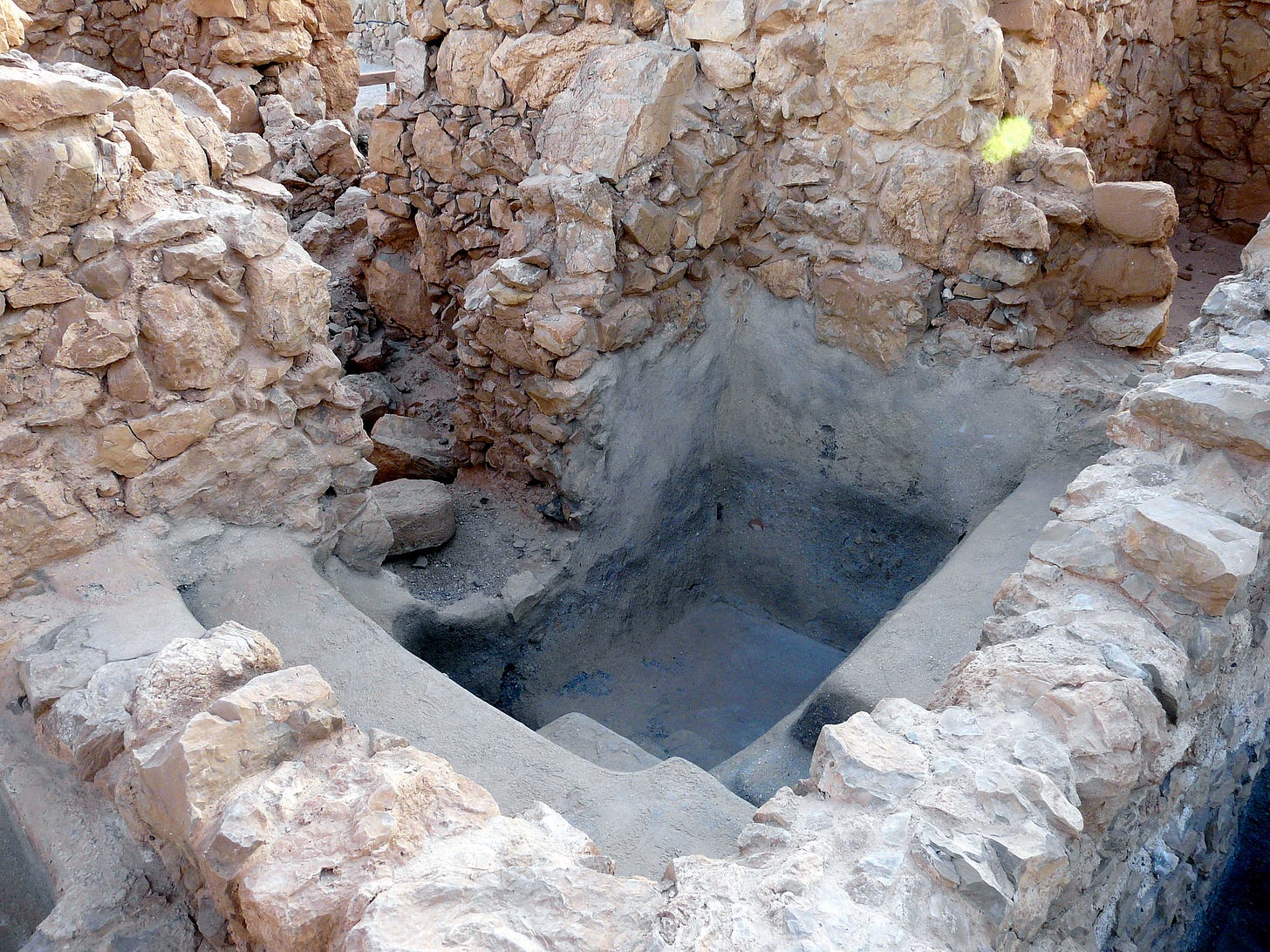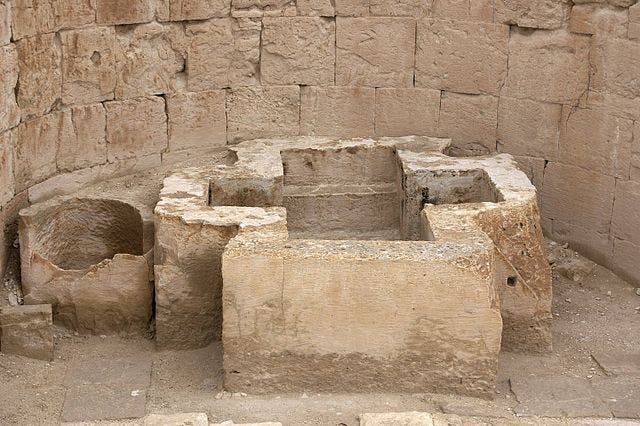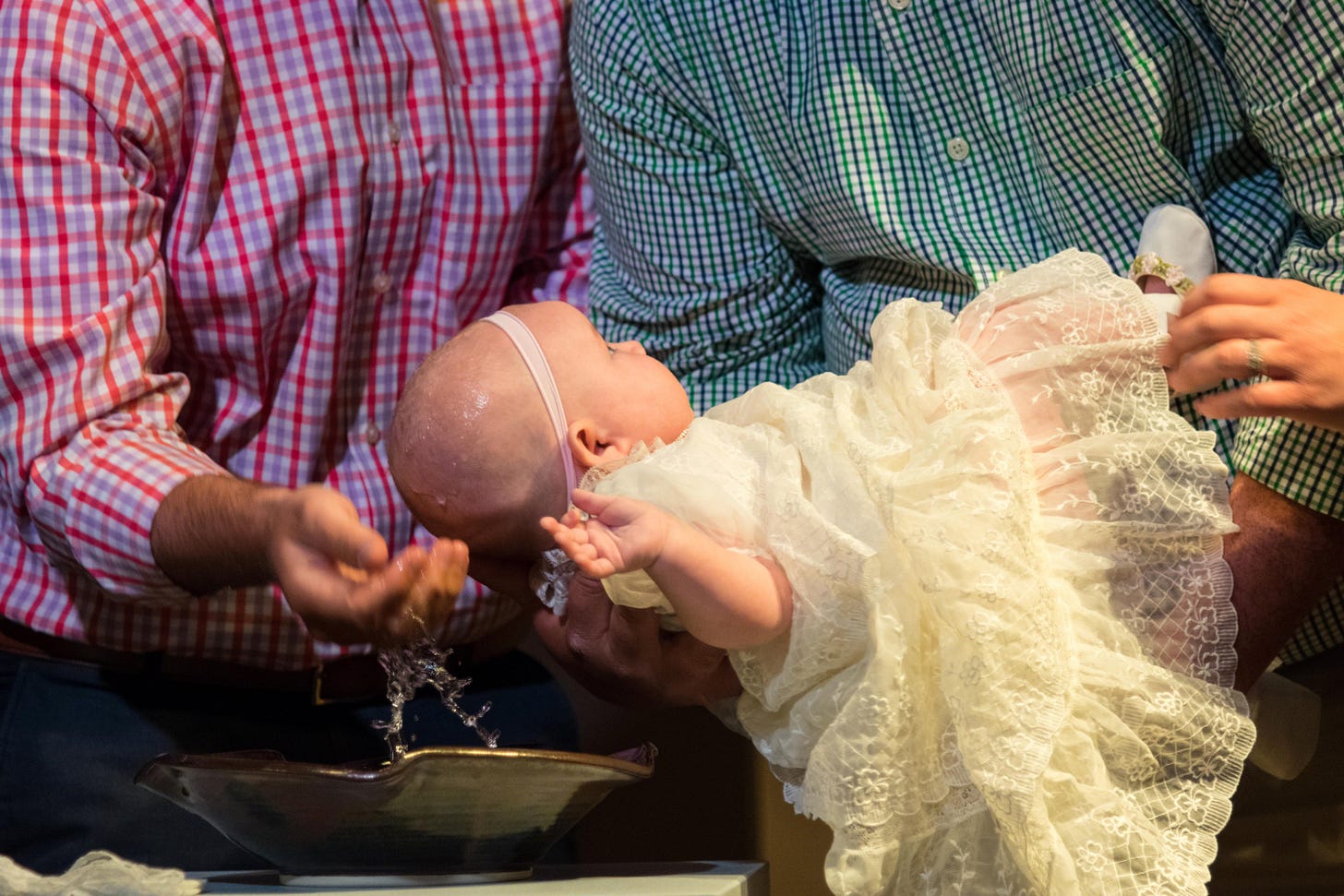The Hidden History of Early Christian Baptism:
What Archaeological Evidence and Ancient Sources Reveal About Christianity's Most Misunderstood Sacrament
Let Me Tell You a True Story
In the year 203 A.D., a young Christian named Perpetua was imprisoned in Carthage for refusing to renounce her faith. She was just 22—a new mother. And in prison, she insisted on being baptized in a stone basin—just days before facing the wild beasts in the arena.

Why? Not because she feared dying.
But because she feared dying without having truly lived in Christ.
Baptism, for Perpetua, was not a symbol.
It was the beginning of the resurrection.
We've made it a formality. A ceremony.
But what if baptism is the very portal to the life you were created for?
What if baptism is your participation in the death and resurrection of Jesus Christ—where the old you dies and the new you is born?
As Paul declared: "Therefore, if anyone is in Christ, the new creation has come: The old has gone, the new is here!" (2 Corinthians 5:17)
The water is not just a bath. It's a grave and a womb at the same time. What dies in the water is your old identity. What rises is your new name.
This isn't a metaphor. This is the most radical transformation available to humanity. Yet we've reduced it to a religious routine.
What if everything you think you know about baptism is wrong?
What if the quiet ceremonies we see in modern churches bear almost no resemblance to the earth-shaking, life-reordering commissioning experiences of early Christianity? What if we've reduced one of history's most powerful transformation processes into a mere religious formality?
After years studying archaeological evidence, ancient manuscripts, and early Christian writings, I've discovered that the journey from spiritual questioning to authentic calling—what I call Sacred Dissonance—follows the exact same pattern that early Christians used to prepare people for baptism. But we've lost this connection, and it's costing us our spiritual power.
The Crisis Hidden in Plain Sight
How Modern Misconceptions Limit Your Spiritual Growth
Right now, millions of spiritually hungry people are trapped between two devastating lies:
Lie #1: "You must fit into our baptismal box"
Denominations insist their method is the only "biblical" way—immersion vs. sprinkling, infant vs. adult, once vs. multiple times. People spend years arguing about methodology while missing the transformational purpose entirely.
Lie #2: "Spiritual questioning means you're losing faith"
Churches treat doubt and spiritual tension as problems to solve quickly rather than sacred invitations to deeper awakening. This forces seekers underground, creating shame around the very dissonance that could birth their greatest gifts.
The Cost of These Lies:
Authentic seekers feel excluded from religious communities
Spiritual growth stagnates at surface-level ritual participation
People suppress their sacred dissonance instead of following it toward their calling
Generations inherit empty religious forms without transformational power
The church loses its prophetic voice because it fears spiritual pioneers
What Happens When You Don't Address Sacred Dissonance
Without understanding the true purpose of spiritual tension, people either:
Remain spiritually stunted, going through religious motions while their souls starve for authentic transformation
Abandon faith entirely, throwing away spiritual wisdom because they can't find space for their questions
Become spiritual refugees, wandering between traditions without finding their true calling
Suppress their gifts, never discovering how their unique spiritual awakening could serve the world
But here's what early Christians understood that we've forgotten: your spiritual dissonance isn't a bug—it's a feature. It's the divine catalyst designed to crack open your soul and awaken the gifts that will fulfill your deepest calling.
The Archaeological Revelations That Change Everything
The historical evidence reveals a stunning truth: early Christian baptism was never about following the "right" method. It was about completing a transformational journey that prepared people to change the world.
Water as Divine Disturbance: From Genesis to Great Commission
The story of baptism doesn't begin in the New Testament. It begins in Genesis.
"And the Spirit of God hovered over the waters." — Genesis 1:2
In the Hebrew worldview, water was chaos—unformed, dangerous, untamed. When God separates the waters, He's not just designing geography. He's subduing disorder.
Throughout Scripture, water continues to mark divine interruption:
Exodus 14 – God splits the Red Sea. Israel escapes slavery, not just geographically—but spiritually.
Joshua 3 – The Jordan River dries up. Israel enters the Promised Land. The water doesn't just part—it marks transition.
Every time water shows up, God is separating the old from the new.
From Mikveh to Kingdom Allegiance
By the time we meet John the Baptist, baptism isn't new. In Second Temple Judaism, Jews practiced mikveh—ritual immersion for purification after impurity, preparation for temple worship, and full-body immersion for converts to Judaism.
But John's baptism was different. He wasn't preparing people for ritual participation. He was preparing them for Kingdom allegiance.
"Repent, for the kingdom of heaven has come near." — Matthew 3:2
John was announcing divine regime change—and baptism was the pledge of allegiance to the new King.
Christ's Revolutionary Identification
Then Jesus shows up. And something unexpected happens.
"I need to be baptized by you," John says, "and do you come to me?"
Jesus replies: "Let it be so now; it is proper for us to do this to fulfill all righteousness." — Matthew 3:13–15
Jesus didn't come to confess sin. He came to identify with sinners.
In going down into the waters of repentance, the Sinless One joined the sinful, beginning His journey toward the cross by publicly embracing our death.
That's the baptism the early church proclaimed: "Do you not know that all of us who were baptized into Christ Jesus were baptized into His death?" — Romans 6:3
Early Christians: Baptism as Ultimate Allegiance
In the early church, baptism wasn't casual. It was costly.
In Acts 2, 3,000 were baptized in one day—publicly identifying with a crucified Messiah, in a Roman world that called Caesar "lord." Baptism wasn't a photo opportunity. It was a public declaration that could get you killed.
For early Christians, baptism marked a total reorientation of identity—from Roman citizen to Kingdom citizen, from cultural participant to Kingdom witness.
As church historian Everett Ferguson documents: "Baptism became the boundary marker, not just between Jew and Gentile, but between the old creation and the new."
The Great Baptism Delay: When Church Leaders Waited Until Death
Here's a fact that destroys assumptions about early Christian practice: some of the most important figures in church history weren't baptized until they were adults—or even until they were dying.
Constantine's Strategic Delay: Emperor Constantine, who legalized Christianity and presided over the Council of Nicaea, wasn't baptized until his deathbed in 337 CE. This wasn't unusual—it was completely normal for prominent Christians of his era.
Church Fathers Who Delayed Baptism:
Ambrose (wasn't baptized until he became bishop)
Gregory of Nazianzus (baptized as an adult despite Christian parents)
Basil of Caesarea (baptized around age 27)
Jerome (baptized as an adult in Rome)
Augustine (baptized at age 33 by Ambrose)
The Strategic Reasoning: Early Christians viewed baptism as providing complete forgiveness of sins. Many concluded it made sense to delay baptism until late in life to maximize its "cleansing effect" and minimize post-baptismal sin.
What This Reveals: If infant baptism had been the universal apostolic practice, why would so many church leaders raised in Christian families delay their own baptism for decades? The evidence points to baptism as a conscious, mature decision about life direction—exactly what we see in Sacred Dissonance journeys.
The Three-Year Transformation: Real Baptismal Preparation
Modern churches often prepare people for baptism in a few weeks. Early Christians took a radically different approach that mirrors the Sacred Dissonance journey perfectly.
The Catechumenate System: Early Christian converts typically underwent 2-3 years of intensive transformation before baptism. This wasn't just Bible study—it was comprehensive life reorientation.
The Three-Stage Journey:
Sacred Dissonance Recognition (Initial Screening): Candidates were examined about their motives, lifestyle, and occupation. Some professions were considered incompatible with Christian life and had to be abandoned. This mirrors the Sacred Dissonance moment when old identities no longer fit.
Gift Awakening Process (Extended Preparation): Catechumens would "hear the word" for three years, with attention focused on lifestyle transformation: "Have they honored the widows? Have they visited the sick? Have they done every good work?" This corresponds to the gift awakening phase, where new capacities emerge.
Calling Preparation (Final Commission): By the 4th and 5th centuries, intensive rites spread over weeks led to Easter baptism, often including personal instruction by the bishop. This paralleled the calling fulfillment stage, where gifts become service.
Partial Membership: Catechumens had limited church participation—they could attend worship but were dismissed before communion. They were becoming Christians, not just declaring it.
Commissioning, Not Just Conversion: Early baptism functioned more like ordination than modern church membership. It commissioned believers for active ministry and world transformation—exactly what authentic Sacred Dissonance journeys produce.
The Forgotten Warfare: Spiritual Battle Preparation
Perhaps the most shocking difference between early and modern baptismal practice involves spiritual warfare. Early Christians saw baptism as a serious spiritual battle requiring intensive preparation.
Mandatory Spiritual Combat Training: Early Christian baptism required multiple "minor exorcisms" performed over catechumens during preparation. This wasn't optional—it was standard procedure for everyone.
Specialized Warriors: The early church had a specific clerical order of "exorcists" whose primary role was preparing candidates for baptism through spiritual warfare training.
The Battle Ritual: Catechumens would face west (symbolizing darkness), stretch out their hands, sometimes spit in defiance of the devil, making formal renunciation. They would then turn east (toward light) and make explicit promises of allegiance to Christ.
Intensive Boot Camp: Some traditions required up to 40 days of prayer, fasting, and spiritual warfare preparation before baptism.
This reveals baptism as commissioning for spiritual battle—preparing people to confront the forces that keep humanity trapped. Modern baptism has lost this warrior dimension entirely.
The Method Question: Ancient Flexibility vs. Modern Rigidity
One of the biggest modern debates concerns baptismal method. The historical evidence reveals that early Christians were far more flexible than contemporary positions suggest.
The Didache's Revolutionary Instructions: The Didache (65-80 CE), one of the earliest Christian manuals, explicitly permits both immersion in living water OR pouring water three times over the head. The emphasis was on spiritual significance, not methodology.
Archaeological Flexibility: While some early baptisteries show immersion pools, many surviving fonts are too shallow for full submersion. Archaeological evidence shows fonts became progressively smaller as practices adapted.
Practical Wisdom: Early Christians adapted methods to available water sources and circumstances, with ancient texts specifically allowing warm water if cold water wasn't available.
No Method Wars: Unlike modern denominational disputes, early Christian sources show remarkable flexibility regarding technique without theological controversy.
The Real Focus: Early Christians cared about transformation, not technique. They understood that arguing about methodology while missing the journey was spiritual malpractice.
The Infant Baptism Timeline: Later Development
The question of when infant baptism began reveals crucial insights about early Christian understanding.
Tertullian's Revealing Opposition: Around 200-220 CE, Tertullian provides our first clear reference to infant baptism—and he argues against it, saying "according to the circumstances and disposition, and even age, of each individual, the delay of baptism is preferable; principally, however, in the case of little children."
The Silence That Speaks: What's crucial is that Tertullian doesn't argue infant baptism was novel—in the ancient world, the most compelling argument against any practice was proving it was new. His failure to make this argument suggests infant baptism existed but wasn't universal.
Emergency Origins: The practice likely originated with emergency baptisms for dying children, gradually expanding from pastoral care to general practice.
Coexistence Evidence: Both infant and adult baptism coexisted for centuries (200s-400s), with neither side condemning the other as heretical.
The Pattern Remains: Whether early or late in life, the underlying journey from dissonance through awakening to calling remained constant.
Your Sacred Dissonance Journey: The Modern Path to Spiritual Commissioning
Here's the revolutionary connection: the same pattern that prepared early Christians for baptismal commissioning is the exact journey your soul needs today. Whether you call it Sacred Dissonance, spiritual awakening, or discovering your life purpose, the stages remain identical.
Where Are You in the Journey?
Stage 1: Sacred Dissonance Recognition
Like early catechumens questioning their old life, you're experiencing spiritual tension where inherited beliefs, roles, or identities no longer satisfy your deeper stirring. This manifests as:
Feeling spiritually "homeless" despite a religious background
Questioning practices or beliefs you once accepted without thought
Sensing you're meant for something more significant than your current path
Experiencing a crisis that strips away superficial spiritual layers
Assessment Question: What inherited spiritual belief or practice feels most confining to your authentic growth right now?
Stage 2: Gift Awakening Process
Like catechumens discovering their spiritual capacities during years of preparation, you're uncovering latent gifts that have been dormant or suppressed. This includes:
New insights emerging from your questioning and exploration
Developing capacities for compassion, wisdom, or creative expression
Finding your voice on issues of justice, healing, or transformation
Experiencing direct spiritual encounters beyond intellectual concepts
Assessment Question: What new capacity or gift has been awakened in you during this time of spiritual questioning?
Stage 3: Calling Fulfillment
Like early Christians being commissioned at baptism for world-changing ministry, you're moving toward expressing your authentic calling through service. This involves:
Integrating personal transformation with meaningful contribution
Creating or reshaping communities, practices, or initiatives
Becoming a source of sanctuary and wisdom for other seekers
Living as an embodied example of the transformation you've experienced
Assessment Question: How is your spiritual journey calling you to serve or contribute to healing the world?
The Modern Catechumenate: Your Supported Transformation
Just as early Christians needed years of community support and structured guidance, your Sacred Dissonance journey requires intentional cultivation in sanctuary environments.
Your Personal Assessment:
Are you trying to navigate spiritual transformation alone?
Do you have a community that honors your questions rather than rushing to "fix" them?
Are you developing practices that support both inner growth and outer service?
Do you have guides who understand the Sacred Dissonance journey?
The Vision: Your Spiritual Commissioning
Imagine emerging from your Sacred Dissonance journey like Perpetua from those baptismal waters—transformed, commissioned, and unstoppable. Picture yourself:
Spiritually Integrated: No longer torn between head and heart, doubt and faith, inner work and outer service
Authentically Powerful: Operating from discovered gifts rather than inherited roles or expectations
Purposefully Engaged: Contributing to healing and transformation in ways uniquely yours
Community Connected: Surrounded by fellow spiritual pioneers who support and challenge your growth
Courageously Aligned: Living from your deepest truth regardless of external pressure or conventional expectations
This isn't fantasy—it's the natural result of completing your Sacred Dissonance journey. Early Christians understood this. Spiritual pioneers throughout history have demonstrated it. Now it's your turn.
If You've Been Baptized but Haven't Been Changed
Now let me say this with tenderness and truth:
If you've been baptized, but your life has not shifted,
If the waters were wet, but not consecrated,
If your old self came back up with you...
Maybe it's time—not to be re-baptized externally, but to reclaim the baptism you already received.
Ask yourself:
Whose death have I joined?
What kingdom have I entered?
Have I surrendered or just complied?
Because baptism is not just about obedience. It's about ownership.
In a world offering endless "self-improvement," Jesus offers something better:
Death to self
Burial of shame
Resurrection into belovedness
The water still speaks. It still calls. Not as ritual—but as revolution.
Your Immediate Next Steps: The Modern Path to Spiritual Commissioning
Step 1: Discover Your Sacred Dissonance Pattern
Take the Sacred Dissonance Quiz to identify which of the 12 universal spiritual journey types most closely matches your experience. Understanding your pattern provides clarity about:
The specific nature of your spiritual tension
The gifts most likely awakening within your journey
The type of calling emerging from your transformation
The community and support most helpful for your path
Step 2: Enter Your Supported Transformation
Consider The Sacred Sanctuary Getaway: THE GIFT AWAKENING™ EXPERIENCE—the modern equivalent of the ancient catechumenate. Here you'll:
Learn to guide Sacred Dissonance rather than suppress it
Discover and develop your emerging spiritual gifts
Connect with fellow travelers on similar journeys
Receive guidance from someone who understands the transformation process
Create practices that support both inner growth and outer service
Step 3: Prepare for Your Commissioning
Begin living as if your spiritual transformation matters not just to you, but to the healing of the world. This means:
Taking your emerging gifts seriously rather than dismissing them
Speaking your truth even when it creates discomfort in conventional settings
Seeking community with other spiritual pioneers rather than trying to fit into spaces that resist growth
Preparing to serve from your authentic calling rather than inherited expectations
Step 4: Dive Deeper into the Complete Framework
Explore The Sacred Dissonance Book for the complete exploration of 12 spiritual pioneers who navigated this same pattern across different eras and traditions. Their stories provide:
Historical validation that you're part of a long tradition of spiritual courage
Practical wisdom about navigating the challenges and opportunities of each stage
Inspiration for what authentic spiritual commissioning can look like
Community with spiritual ancestors who blazed the trail you're walking
About Your Guide on This Journey
Bernadette Oblena-Purto (Master Coach A) brings unique qualifications to guide Sacred Dissonance journeys. As a transformative thought leader, coaching entrepreneur, and spiritual guide working at the intersection of inner awakening and collective impact, she understands both the personal and social dimensions of spiritual transformation.
With specialized studies in emotional trauma healing and recovery, she serves as a Mental Health Coach to individuals who struggle with traditional and modern medical approaches, helping them find spiritual refuge as a foundation for healing. As founder of Life Coach Philippines-International and the Coach Your Gift Movement, she empowers individuals to transform spiritual gifts into purposeful calling.
Her sanctuary space, D' Cup Coffee Republic, operates as a safe hub for meaningful connection and conversation, creating environments where those navigating emotional challenges can find acceptance, understanding, and pathways to mental fitness.
Rooted in contemplative tradition and social application, Master Coach A combines theological formation as a Church Planter from Axx Bible College with practical experience as a community leader and retreat designer. Her core message resonates globally: Your dissonance may be the birthplace of your truest calling.
She has walked her own Sacred Dissonance journey from traditional religious expectations toward authentic spiritual pioneering, making her uniquely qualified to guide others through this transformative process.
Come Back to the Water: Your Sacred Dissonance Revolution
You stand at the same crossroads as Perpetua, as every spiritual pioneer throughout history, as early Christians preparing for commissioning. You can:
Continue suppressing your Sacred Dissonance, trying to fit into spiritual frameworks that no longer serve your growth, remaining spiritually homeless while your gifts stay dormant...
Or embrace your Sacred Dissonance as the divine invitation it is, follow it through supported transformation toward your authentic calling, and emerge spiritually commissioned to contribute your unique gifts to healing the world.
The early Christians understood: baptism was never about getting the method right. It was about joining Christ's death and resurrection—the ultimate Sacred Dissonance journey where the old dies and the new is born.
Your Sacred Dissonance journey is that same transformational path. The question isn't whether you're spiritual enough—it's whether you're courageous enough to let your spiritual tension become your spiritual power.
So if your soul is dry, if your faith feels distant, if your calling is cloudy...
Don't just go back to church.
Come back to the water.
Begin your Sacred Dissonance journey at mastercoacha.com/sacred-dissonance









Resonating with this, "So if your soul is dry, if your faith feels distant, if your calling is cloudy...
Don't just go back to church.
Come back to the water." Thank you Master Coach A. Remembering my Dad before when he prefers us to go to the river or to the beach than going to church. I think here's the further explanation with this experience with my father.